 Love Albrecht Howard’s first book fills a gap in our collection. To my knowledge, it is the only recent book on running a garden design business that is written for plant lovers who may not have formal horticultural or business training, but who do have a fair amount of common sense and are willing to get their hands (and feet!) dirty learning. The author certainly approves of formal education, recommending that prospective designers take courses, but she knows firsthand that hands-on experience gained through internships, volunteer work, and garden shows, as well as time spent with gardening books and magazines can be even more valuable than coursework. Indeed, fifteen out of twenty chapters focus on day-to-day operations, including best gardening practices, rather than on estimating costs, hiring staff, and other money-related aspects of the business.
Love Albrecht Howard’s first book fills a gap in our collection. To my knowledge, it is the only recent book on running a garden design business that is written for plant lovers who may not have formal horticultural or business training, but who do have a fair amount of common sense and are willing to get their hands (and feet!) dirty learning. The author certainly approves of formal education, recommending that prospective designers take courses, but she knows firsthand that hands-on experience gained through internships, volunteer work, and garden shows, as well as time spent with gardening books and magazines can be even more valuable than coursework. Indeed, fifteen out of twenty chapters focus on day-to-day operations, including best gardening practices, rather than on estimating costs, hiring staff, and other money-related aspects of the business.
To its credit, this book has a comprehensive index, with topics ranging from accent plants to Rocky Mountain spotted fever to zone creep. Albrecht Howard offers a wealth of knowledge gained from real-world experience, along with basic guidelines to help ensure the fledgling business does well financially. The underlying message is one most readers will want to hear: if a new designer can perfect skills in garden design, plant care, and customer relations, the money is secondary, and it will come.
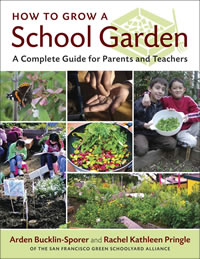 The authors, who are members of the San Francisco Green Schoolyard Alliance, recognize a fact that is becoming clear in schools across the country: if we are to have school gardens in this era of tightening budgets, increased academic testing and expanding class sizes, parents must step up and offer their time and energy to establish and maintain them. My own personal experience with this process as a volunteer in the garden at my neighborhood elementary school indicates that while a few parents at each school might have the necessary time and energy to devote to this, it is rare to find anyone at all with the practical knowledge, patience and understanding that are necessary to make such a garden flourish. That’s why this book is so important and useful. Not only does it empower parents and teachers to get something growing, it educates them about the planning, funding, building, maintenance, use, and enjoyment of such a garden. Valuable topics include dealing with vandalism, training students in basic garden tasks, preparing for garden lessons, scheduling class activities in the garden, and planning for summer watering. This book is a must-have for any gardening library.
The authors, who are members of the San Francisco Green Schoolyard Alliance, recognize a fact that is becoming clear in schools across the country: if we are to have school gardens in this era of tightening budgets, increased academic testing and expanding class sizes, parents must step up and offer their time and energy to establish and maintain them. My own personal experience with this process as a volunteer in the garden at my neighborhood elementary school indicates that while a few parents at each school might have the necessary time and energy to devote to this, it is rare to find anyone at all with the practical knowledge, patience and understanding that are necessary to make such a garden flourish. That’s why this book is so important and useful. Not only does it empower parents and teachers to get something growing, it educates them about the planning, funding, building, maintenance, use, and enjoyment of such a garden. Valuable topics include dealing with vandalism, training students in basic garden tasks, preparing for garden lessons, scheduling class activities in the garden, and planning for summer watering. This book is a must-have for any gardening library.
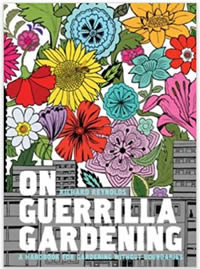
Have you ever passed by a patch of barren, overgrown or otherwise neglected ground and thought, “Someone should plant a garden there?” Richard Reynolds not only did, he established and nurtured a garden at his housing block’s previously bleak site. And then he went one better, and founded a movement that has spread worldwide. He fervently believes that gardening should not be the exclusive province of those who own property or manage to score a coveted spot at the P-patch. Instead, he advocates taking over landscape installation and maintenance anywhere it is not already being done, or done well, in public and private spaces alike.
Despite his almost comically serious reliance on the language and “lessons” of actual guerrilla warfare (the book starts out with Che and Mao, shows a photo of seed “bombs” in the shape of a 9mm pistol, and gardeners can sign up at www.guerrillagardening.com to get a “troop number”), Reynolds aims to inspire beautification, so half the book is devoted to practical advice. He addresses the myriad issues an aspiring guerrilla gardener must face, from site selection to plant choice for hardiness and maximum visual impact, the non-availability of water, how to discourage vandalism, and, eventually, perhaps legitimize the established garden.
Of course, humans have been sneaking seeds and plants into spaces that are technically not their own for millennia – Reynolds just gave their actions a name and labeled it a cause.
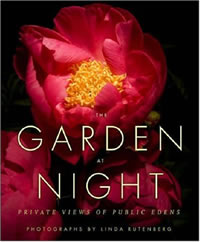 As a resident of Montreal, Linda Rutenberg does not qualify as a Pacific Northwest author, but the collection of her photographs in the 2007 publication “The Garden at Night: Private Views of Public Eden” includes PNW subjects. The Washington Park Arboretum and the Butchart Gardens are both featured, as are several other west coast gardens. The Italian Garden at Butchart is particularly enchanting at night, and one simply must experience Azalea Way — after dark!
As a resident of Montreal, Linda Rutenberg does not qualify as a Pacific Northwest author, but the collection of her photographs in the 2007 publication “The Garden at Night: Private Views of Public Eden” includes PNW subjects. The Washington Park Arboretum and the Butchart Gardens are both featured, as are several other west coast gardens. The Italian Garden at Butchart is particularly enchanting at night, and one simply must experience Azalea Way — after dark!
Excerpted from the Fall 2009 Arboretum Bulletin.
 “The Northwest Green Home Primer” is a helpful book for planning your garden. While the emphasis is on the home, a chapter entitled “Site Choices” has good advice for the surrounding landscaping, especially how and where to plant trees, and briefly addresses other green practices such as rain gardens to maximize the use of runoff.
“The Northwest Green Home Primer” is a helpful book for planning your garden. While the emphasis is on the home, a chapter entitled “Site Choices” has good advice for the surrounding landscaping, especially how and where to plant trees, and briefly addresses other green practices such as rain gardens to maximize the use of runoff.
Excerpted from the Fall 2009 Arboretum Bulletin.
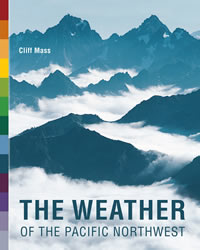 Briefly, gardeners should read “The Weather of the Pacific Northwest” by Cliff Mass, as the local weather is our constant companion. While this doesn’t specifically address the concerns of gardeners, it will help you make sense of forecasts and appreciate the unpredictability of our weather.
Briefly, gardeners should read “The Weather of the Pacific Northwest” by Cliff Mass, as the local weather is our constant companion. While this doesn’t specifically address the concerns of gardeners, it will help you make sense of forecasts and appreciate the unpredictability of our weather.
Excerpted from the Fall 2009 Arboretum Bulletin.
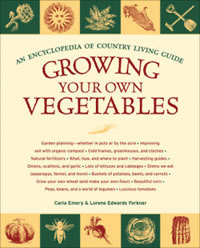 Lorene Edwards Forkner tackled a huge task. She took the 900 plus pages of the late Carla Emery’s “The Encyclopedia of Country Living” and distilled out of this sometimes wandering magnum opus (in 10 editions over 35 years) the essentials of vegetable gardening.
Lorene Edwards Forkner tackled a huge task. She took the 900 plus pages of the late Carla Emery’s “The Encyclopedia of Country Living” and distilled out of this sometimes wandering magnum opus (in 10 editions over 35 years) the essentials of vegetable gardening.
The resulting “Growing Your Own Vegetables” is a well organized and very readable work (at a comparatively slim 179 pages) that still captures the enthusiasm and down-to-earth charm of the original. While the authors both have Pacific Northwest roots, this book is written for a general audience, and so the section on okra is best skipped in planning your Seattle P-patch.
That said, there are still lots of useful and practical cultural tips. But I found it most charming in the somewhat quirky side boxes, such as that on Draft Horses and Power Tools: “Pat the animal and let it know you appreciate it after a good hard pull.”
Excerpted from the Fall 2009 Arboretum Bulletin.
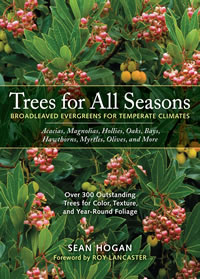 Portlander nurseryman Sean Hogan addresses a neglected part of the garden palette in “Trees for All Seasons: Broadleaved Evergreens for Temperate Climates”. And he does it with great enthusiasm; being quite candid that one of his goals is increased planting of these excellent but underused plants.
Portlander nurseryman Sean Hogan addresses a neglected part of the garden palette in “Trees for All Seasons: Broadleaved Evergreens for Temperate Climates”. And he does it with great enthusiasm; being quite candid that one of his goals is increased planting of these excellent but underused plants.
First, he defines his scope. Conifers, or monocots such as palms, are not included. He’s also strict about evergreen, subjects must “…keep their leaves year-round, or nearly so, but also remain attractive while doing so.” Icons with each entry give size and shape, and emphasize these are trees, not shrubs (he’s saving those for his next book).
The typical A-Z encyclopedia — with some bunching of closely related genera — is written for horticulturists (not botanists!) in temperate zones, and gives considerable gradation to the cold-hardiness and other exacting, cultural needs. For example, I learned that a favorite tree of mine from trips to the southwest, the Texas mountain laurel (Sophora secundiflora) would “…experience imperceptibly slow growth, or even lose ground…” in my Seattle garden without heroic efforts to match its preferred “swamp-cooler” climate.
Always the nurseryman, Hogan gives detailed notes about propagation and the habits of young nursery stock, always written in an easy to understand manner. Need to propagate your olive? Historically this was done by “chopping the heavily burled bases into pieces, pulling chunks out of the ground, then dragging them to the next area where, eventually, an olive tree would grow.” He goes on to say that with less effort similar results can be obtained from well-ripened cuttings with a high…ish level of hormone…along with a steep wound.”
This book will certainly enhance your appreciation of the Arboretum’s collection of broadleaved evergreens.
Excerpted from the Fall 2009 Arboretum Bulletin.
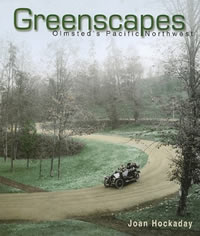 John Charles Olmsted made numerous visits to the Pacific Northwest from 1903-1911. This nephew of Frederick Law Olmsted was himself a highly regarded landscape architect and noted for his attention to fine detail. The chronicle of his many projects in the region is written with this same, careful attention to detail by Joan Hockaday in “Greenscapes: Olmsted’s Pacific Northwest.”
John Charles Olmsted made numerous visits to the Pacific Northwest from 1903-1911. This nephew of Frederick Law Olmsted was himself a highly regarded landscape architect and noted for his attention to fine detail. The chronicle of his many projects in the region is written with this same, careful attention to detail by Joan Hockaday in “Greenscapes: Olmsted’s Pacific Northwest.”
Olmsted was a prolific writer, both in his professional records and in his correspondence (5,000 private letters survive), especially his daily letters to his wife Sophia and their daughters at home in Brookline, Massachusetts. Hockaday uses this wealth of sources to create a book that works on several levels: as a history of a important time in the development of our region, as a biography of a skilled landscape architect working in the shadow of his more famous uncle, and as a glimpse of a by-gone era through garden design.
While his work took him from Vancouver Island to the University of Idaho and south to Corvallis, much the book’s focus is on Seattle, where he spent some 300 days during those nine years. Hockaday convincingly argues that Olmsted is responsible for much of what now defines the city, especially with the park system, Lake Washington Boulevard, the University of Washington campus (including Rainier Vista), and many private residences.
Excerpted from the Fall 2009 Arboretum Bulletin.
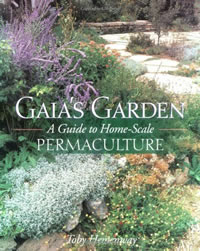 Start healing the planet right in your own backyard! Learn about the principles of ecological garden design, water conservation strategies and supporting wildlife from Toby Hemenway, author of Gaia’s Garden: A Guide to Home-Scale Permaculture. Inspiring anecdotes make this book fun to read, while practical advice, illustrated examples and long lists of useful plants help gardeners start transforming their backyards right away.
Start healing the planet right in your own backyard! Learn about the principles of ecological garden design, water conservation strategies and supporting wildlife from Toby Hemenway, author of Gaia’s Garden: A Guide to Home-Scale Permaculture. Inspiring anecdotes make this book fun to read, while practical advice, illustrated examples and long lists of useful plants help gardeners start transforming their backyards right away.
 Love Albrecht Howard’s first book fills a gap in our collection. To my knowledge, it is the only recent book on running a garden design business that is written for plant lovers who may not have formal horticultural or business training, but who do have a fair amount of common sense and are willing to get their hands (and feet!) dirty learning. The author certainly approves of formal education, recommending that prospective designers take courses, but she knows firsthand that hands-on experience gained through internships, volunteer work, and garden shows, as well as time spent with gardening books and magazines can be even more valuable than coursework. Indeed, fifteen out of twenty chapters focus on day-to-day operations, including best gardening practices, rather than on estimating costs, hiring staff, and other money-related aspects of the business.
Love Albrecht Howard’s first book fills a gap in our collection. To my knowledge, it is the only recent book on running a garden design business that is written for plant lovers who may not have formal horticultural or business training, but who do have a fair amount of common sense and are willing to get their hands (and feet!) dirty learning. The author certainly approves of formal education, recommending that prospective designers take courses, but she knows firsthand that hands-on experience gained through internships, volunteer work, and garden shows, as well as time spent with gardening books and magazines can be even more valuable than coursework. Indeed, fifteen out of twenty chapters focus on day-to-day operations, including best gardening practices, rather than on estimating costs, hiring staff, and other money-related aspects of the business. The authors, who are members of the San Francisco Green Schoolyard Alliance, recognize a fact that is becoming clear in schools across the country: if we are to have school gardens in this era of tightening budgets, increased academic testing and expanding class sizes, parents must step up and offer their time and energy to establish and maintain them. My own personal experience with this process as a volunteer in the garden at my neighborhood elementary school indicates that while a few parents at each school might have the necessary time and energy to devote to this, it is rare to find anyone at all with the practical knowledge, patience and understanding that are necessary to make such a garden flourish. That’s why this book is so important and useful. Not only does it empower parents and teachers to get something growing, it educates them about the planning, funding, building, maintenance, use, and enjoyment of such a garden. Valuable topics include dealing with vandalism, training students in basic garden tasks, preparing for garden lessons, scheduling class activities in the garden, and planning for summer watering. This book is a must-have for any gardening library.
The authors, who are members of the San Francisco Green Schoolyard Alliance, recognize a fact that is becoming clear in schools across the country: if we are to have school gardens in this era of tightening budgets, increased academic testing and expanding class sizes, parents must step up and offer their time and energy to establish and maintain them. My own personal experience with this process as a volunteer in the garden at my neighborhood elementary school indicates that while a few parents at each school might have the necessary time and energy to devote to this, it is rare to find anyone at all with the practical knowledge, patience and understanding that are necessary to make such a garden flourish. That’s why this book is so important and useful. Not only does it empower parents and teachers to get something growing, it educates them about the planning, funding, building, maintenance, use, and enjoyment of such a garden. Valuable topics include dealing with vandalism, training students in basic garden tasks, preparing for garden lessons, scheduling class activities in the garden, and planning for summer watering. This book is a must-have for any gardening library.
 As a resident of Montreal, Linda Rutenberg does not qualify as a Pacific Northwest author, but the collection of her photographs in the 2007 publication “The Garden at Night: Private Views of Public Eden” includes PNW subjects. The Washington Park Arboretum and the Butchart Gardens are both featured, as are several other west coast gardens. The Italian Garden at Butchart is particularly enchanting at night, and one simply must experience Azalea Way — after dark!
As a resident of Montreal, Linda Rutenberg does not qualify as a Pacific Northwest author, but the collection of her photographs in the 2007 publication “The Garden at Night: Private Views of Public Eden” includes PNW subjects. The Washington Park Arboretum and the Butchart Gardens are both featured, as are several other west coast gardens. The Italian Garden at Butchart is particularly enchanting at night, and one simply must experience Azalea Way — after dark! “The Northwest Green Home Primer” is a helpful book for planning your garden. While the emphasis is on the home, a chapter entitled “Site Choices” has good advice for the surrounding landscaping, especially how and where to plant trees, and briefly addresses other green practices such as rain gardens to maximize the use of runoff.
“The Northwest Green Home Primer” is a helpful book for planning your garden. While the emphasis is on the home, a chapter entitled “Site Choices” has good advice for the surrounding landscaping, especially how and where to plant trees, and briefly addresses other green practices such as rain gardens to maximize the use of runoff. Briefly, gardeners should read “The Weather of the Pacific Northwest” by Cliff Mass, as the local weather is our constant companion. While this doesn’t specifically address the concerns of gardeners, it will help you make sense of forecasts and appreciate the unpredictability of our weather.
Briefly, gardeners should read “The Weather of the Pacific Northwest” by Cliff Mass, as the local weather is our constant companion. While this doesn’t specifically address the concerns of gardeners, it will help you make sense of forecasts and appreciate the unpredictability of our weather. Lorene Edwards Forkner tackled a huge task. She took the 900 plus pages of the late Carla Emery’s “The Encyclopedia of Country Living” and distilled out of this sometimes wandering magnum opus (in 10 editions over 35 years) the essentials of vegetable gardening.
Lorene Edwards Forkner tackled a huge task. She took the 900 plus pages of the late Carla Emery’s “The Encyclopedia of Country Living” and distilled out of this sometimes wandering magnum opus (in 10 editions over 35 years) the essentials of vegetable gardening. Portlander nurseryman Sean Hogan addresses a neglected part of the garden palette in “Trees for All Seasons: Broadleaved Evergreens for Temperate Climates”. And he does it with great enthusiasm; being quite candid that one of his goals is increased planting of these excellent but underused plants.
Portlander nurseryman Sean Hogan addresses a neglected part of the garden palette in “Trees for All Seasons: Broadleaved Evergreens for Temperate Climates”. And he does it with great enthusiasm; being quite candid that one of his goals is increased planting of these excellent but underused plants. John Charles Olmsted made numerous visits to the Pacific Northwest from 1903-1911. This nephew of Frederick Law Olmsted was himself a highly regarded landscape architect and noted for his attention to fine detail. The chronicle of his many projects in the region is written with this same, careful attention to detail by Joan Hockaday in “Greenscapes: Olmsted’s Pacific Northwest.”
John Charles Olmsted made numerous visits to the Pacific Northwest from 1903-1911. This nephew of Frederick Law Olmsted was himself a highly regarded landscape architect and noted for his attention to fine detail. The chronicle of his many projects in the region is written with this same, careful attention to detail by Joan Hockaday in “Greenscapes: Olmsted’s Pacific Northwest.” Start healing the planet right in your own backyard! Learn about the principles of ecological garden design, water conservation strategies and supporting wildlife from Toby Hemenway, author of Gaia’s Garden: A Guide to Home-Scale Permaculture. Inspiring anecdotes make this book fun to read, while practical advice, illustrated examples and long lists of useful plants help gardeners start transforming their backyards right away.
Start healing the planet right in your own backyard! Learn about the principles of ecological garden design, water conservation strategies and supporting wildlife from Toby Hemenway, author of Gaia’s Garden: A Guide to Home-Scale Permaculture. Inspiring anecdotes make this book fun to read, while practical advice, illustrated examples and long lists of useful plants help gardeners start transforming their backyards right away.